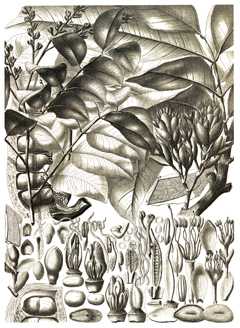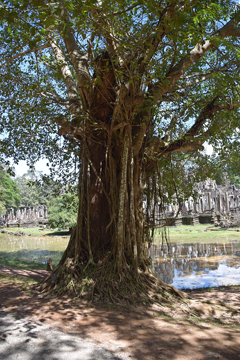 |
|
http://www.edibleplants.org/ |
 |
| wikimedia.org User:Tournasol7 |
Translate this page:
Summary
Afzelia xylocarpa - Makha Tree or Cambodia Beng Tree – is a large tropical deciduous tree that can grow to 30m. In very large specimens the trunk to grow to 2m in diameter. The tree has an attractive timber used for ornamental woodturning, pens, knife handles, carvings, and musical instruments. The seed and oil are edible and is medicinally for eye disease and toothaches relief. Cigarettes are made from the seed pulp. Leaves are high in nitrogen and help improve soil conditions.
Physical Characteristics

 Afzelia xylocarpa is a deciduous Tree growing to 20 m (65ft) by 12 m (39ft) at a medium rate.
Afzelia xylocarpa is a deciduous Tree growing to 20 m (65ft) by 12 m (39ft) at a medium rate.
See above for USDA hardiness. It is hardy to UK zone 10 and is frost tender.
It can fix Nitrogen.
Suitable for: light (sandy), medium (loamy) and heavy (clay) soils and prefers well-drained soil. Suitable pH: neutral soils. It cannot grow in the shade. It prefers moist soil.
UK Hardiness Map
US Hardiness Map
Synonyms
Afzelia cochinchinensis (Pierre) J.Léonard Afzelia siamica Craib. Pahudia cochinchinensis Pierre Pah
Plant Habitats
Edible Uses
Edible Parts: Leaves Oil Seed
Edible Uses: Oil
Edible Part: Leaves, Seeds, Oil. The fatty cotyledons of young seeds are eaten[ 325 , 384 , 404 ]. An oil is obtained from the seeds[ 404 ].
References More on Edible Uses
Medicinal Uses
Plants For A Future can not take any responsibility for any adverse effects from the use of plants. Always seek advice from a professional before using a plant medicinally.
Astringent
The plant is used medicinally for relieving toothaches and eye diseases[ 266 ]. The bark is astringent[ 404 ]. It is used in local medicine[ 404 ].
References More on Medicinal Uses
The Bookshop: Edible Plant Books
Our Latest books on Perennial Plants For Food Forests and Permaculture Gardens in paperback or digital formats.

Edible Tropical Plants
Food Forest Plants for Hotter Conditions: 250+ Plants For Tropical Food Forests & Permaculture Gardens.
More

Edible Temperate Plants
Plants for Your Food Forest: 500 Plants for Temperate Food Forests & Permaculture Gardens.
More

More Books
PFAF have eight books available in paperback and digital formats. Browse the shop for more information.
Shop Now
Other Uses
Adhesive Oil Soil conditioner Tannin Wood
Agroforestry Uses: The tree is grown in agroforestry systems, where they improve soil conditions through their nitrogen-fixing ability and leaf fall[ 362 ]. Other Uses The seeds are used for carving[ 266 ]. An adhesive is made from the seed pulp[ 404 ]. The bark contains tannins[ 384 , 404 ]. The heartwood is reddish-yellow, red to dirty red-brown, often with some streaks, and clearly demarcated from the grey-white sapwood[ 404 ]. The texture is moderately fine to moderately coarse[ 404 ]. The wood is heavy, hard, very durable (tests have shown a durability under exposure of about 10 years in tropical conditions)[ 404 ]. It is moderately difficult to work, but easy in comparison with other high-density woods; planed surfaces are often glossy; it takes a high finish[ 404 ]. The attractive wood is highly valued for carpentry[ 338 , 404 ]. The hard, dense, fine-grained and durable wood is highly valued, especially in Thailand. The wood is used in various ways, for round wood, building poles, sawn or hewn building timbers, for heavy and light construction, beams, flooring, wall panelling, shingles, engineering structures, bridges, railway sleepers, woodware, industrial and domestic woodware, tool handles, musical instruments, wood carvings, furniture, veneers, boats, vehicle bodies, wood based materials, plywood, fuel wood and charcoal. The wood burls are specially valued because they form beautiful figures when the wood is being cut. The wood is so valuable that it is sold by kilograms[ 404 ].
Special Uses
Coppice Food Forest Nitrogen Fixer
References More on Other Uses
Cultivation details
A plant of the moist tropics, where it is usually found at elevations from 100 - 650 metres[ 404 ]. It grows best in areas where annual daytime annual temperatures are within the range 20 - 32°c, though it can tolerate 12 - 39°c[ 404 ]. It does badly if temperatures fall below10°c[ 404 ]. It prefers a mean annual rainfall in the range 1,000 - 1,500mm, with a dry season of 5 - 6 months[ 404 ]. Young plants prefer some shade, but become increasingly intolerant of shade as they grow older[ 404 ]. Thrives on well-drained flats or on slopes with a deep, loamy soil, or sand on clayey or laterite soils with a neutral pH[ 404 ]. The tree has good coppice potential[ 404 ]. Seedpods remain on the tree for a long time before opening[ 362 ]. This species has a symbiotic relationship with certain soil bacteria, these bacteria form nodules on the roots and fix atmospheric nitrogen. Some of this nitrogen is utilized by the growing plant but some can also be used by other plants growing nearby[ 200 ].
References Carbon Farming Information and Carbon Sequestration Information
Temperature Converter
Type a value in the Celsius field to convert the value to Fahrenheit:
Fahrenheit:
The PFAF Bookshop
Plants For A Future have a number of books available in paperback and digital form. Book titles include Edible Plants, Edible Perennials, Edible Trees,Edible Shrubs, Woodland Gardening, and Temperate Food Forest Plants. Our new book is Food Forest Plants For Hotter Conditions (Tropical and Sub-Tropical).
Shop Now
Plant Propagation
Seed - the seedcoat is so hard that pre-treatment with boiling water may not be sufficient to break the dormancy. Furthermore, the large aril around the seed delays germination and must be removed. By using a sharp knife, it is possible to cut off the aril together with a small chip of the seedcoat but care must be taken not to damage the radicle. If the seed coat is not scarified while removing the aril, the seed should be nicked at the opposite end. After cutting, the seeds are soaked in water for 12 hours before sowing[ 404 ]. Generally germination ability lasts 1 - 2 years when seeds are stored in low temperatures[ 404 ].
Other Names
If available other names are mentioned here
Native Range
TROPICAL ASIA: Cambodia, Laos, Myanmar, Thailand, Vietnam
Weed Potential
Right plant wrong place. We are currently updating this section.
Please note that a plant may be invasive in one area but may not in your area so it's worth checking.
Conservation Status
IUCN Red List of Threatened Plants Status : Afzelia xylocarpa
Status: Endangered

Growth: S = slow M = medium F = fast. Soil: L = light (sandy) M = medium H = heavy (clay). pH: A = acid N = neutral B = basic (alkaline). Shade: F = full shade S = semi-shade N = no shade. Moisture: D = dry M = Moist We = wet Wa = water.
Now available:
Food Forest Plants for Mediterranean Conditions
350+ Perennial Plants For Mediterranean and Drier Food Forests and Permaculture Gardens.
[Paperback and eBook]
This is the third in Plants For A Future's series of plant guides for food forests tailored to
specific climate zones. Following volumes on temperate and tropical ecosystems, this book focuses
on species suited to Mediterranean conditions—regions with hot, dry summers and cool, wet winters,
often facing the added challenge of climate change.
Read More
Expert comment
Author
(Kurz) Craib
Botanical References
325404
Links / References
For a list of references used on this page please go here
Readers comment
| Add a comment |
|
If you have important information about this plant that may help other users please add a comment or link below. Only comments or links that are felt to be directly relevant to a plant will be included. If you think a comment/link or information contained on this page is inaccurate or misleading we would welcome your feedback at [email protected]. If you have questions about a plant please use the Forum on this website as we do not have the resources to answer questions ourselves.
* Please note: the comments by website users are not necessarily those held by PFAF and may give misleading or inaccurate information.
To leave a comment please Register or login here All comments need to be approved so will not appear immediately.
|
Subject : Afzelia xylocarpa
|
|
|
|